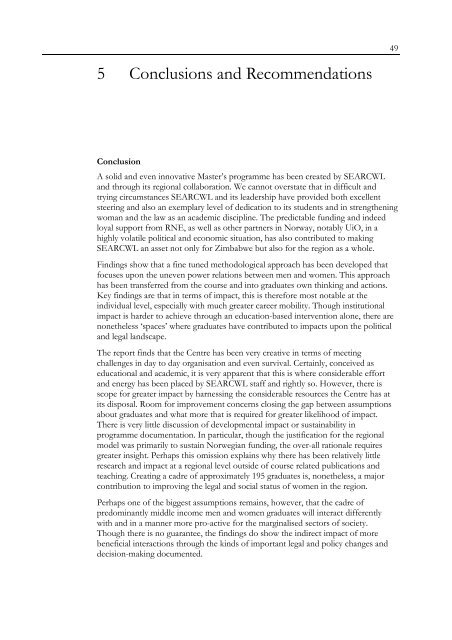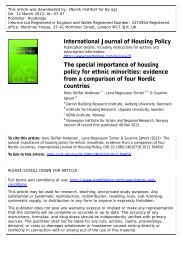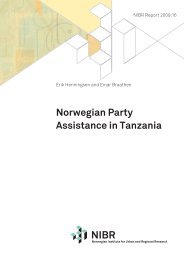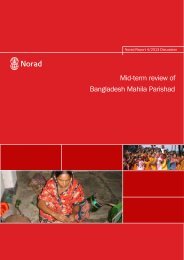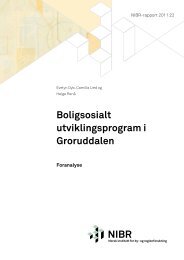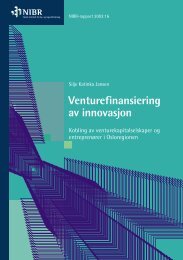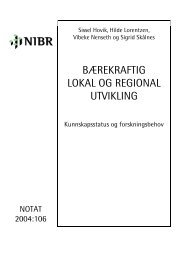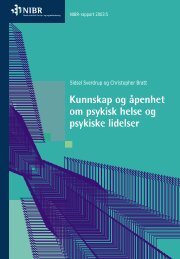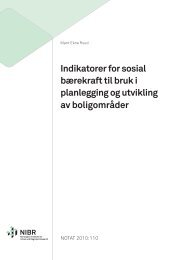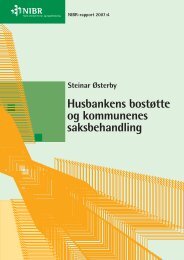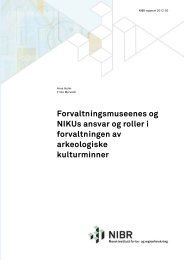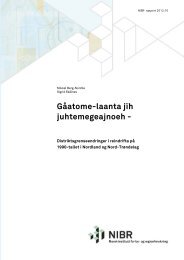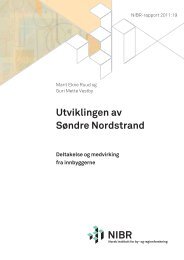Evaluation of the Southern and Eastern Africa Regional Centre for ...
Evaluation of the Southern and Eastern Africa Regional Centre for ...
Evaluation of the Southern and Eastern Africa Regional Centre for ...
- No tags were found...
Create successful ePaper yourself
Turn your PDF publications into a flip-book with our unique Google optimized e-Paper software.
495 Conclusions <strong>and</strong> RecommendationsConclusionA solid <strong>and</strong> even innovative Master’s programme has been created by SEARCWL<strong>and</strong> through its regional collaboration. We cannot overstate that in difficult <strong>and</strong>trying circumstances SEARCWL <strong>and</strong> its leadership have provided both excellentsteering <strong>and</strong> also an exemplary level <strong>of</strong> dedication to its students <strong>and</strong> in streng<strong>the</strong>ningwoman <strong>and</strong> <strong>the</strong> law as an academic discipline. The predictable funding <strong>and</strong> indeedloyal support from RNE, as well as o<strong>the</strong>r partners in Norway, notably UiO, in ahighly volatile political <strong>and</strong> economic situation, has also contributed to makingSEARCWL an asset not only <strong>for</strong> Zimbabwe but also <strong>for</strong> <strong>the</strong> region as a whole.Findings show that a fine tuned methodological approach has been developed thatfocuses upon <strong>the</strong> uneven power relations between men <strong>and</strong> women. This approachhas been transferred from <strong>the</strong> course <strong>and</strong> into graduates own thinking <strong>and</strong> actions.Key findings are that in terms <strong>of</strong> impact, this is <strong>the</strong>re<strong>for</strong>e most notable at <strong>the</strong>individual level, especially with much greater career mobility. Though institutionalimpact is harder to achieve through an education-based intervention alone, <strong>the</strong>re arenone<strong>the</strong>less ‘spaces’ where graduates have contributed to impacts upon <strong>the</strong> political<strong>and</strong> legal l<strong>and</strong>scape.The report finds that <strong>the</strong> <strong>Centre</strong> has been very creative in terms <strong>of</strong> meetingchallenges in day to day organisation <strong>and</strong> even survival. Certainly, conceived aseducational <strong>and</strong> academic, it is very apparent that this is where considerable ef<strong>for</strong>t<strong>and</strong> energy has been placed by SEARCWL staff <strong>and</strong> rightly so. However, <strong>the</strong>re isscope <strong>for</strong> greater impact by harnessing <strong>the</strong> considerable resources <strong>the</strong> <strong>Centre</strong> has atits disposal. Room <strong>for</strong> improvement concerns closing <strong>the</strong> gap between assumptionsabout graduates <strong>and</strong> what more that is required <strong>for</strong> greater likelihood <strong>of</strong> impact.There is very little discussion <strong>of</strong> developmental impact or sustainability inprogramme documentation. In particular, though <strong>the</strong> justification <strong>for</strong> <strong>the</strong> regionalmodel was primarily to sustain Norwegian funding, <strong>the</strong> over-all rationale requiresgreater insight. Perhaps this omission explains why <strong>the</strong>re has been relatively littleresearch <strong>and</strong> impact at a regional level outside <strong>of</strong> course related publications <strong>and</strong>teaching. Creating a cadre <strong>of</strong> approximately 195 graduates is, none<strong>the</strong>less, a majorcontribution to improving <strong>the</strong> legal <strong>and</strong> social status <strong>of</strong> women in <strong>the</strong> region.Perhaps one <strong>of</strong> <strong>the</strong> biggest assumptions remains, however, that <strong>the</strong> cadre <strong>of</strong>predominantly middle income men <strong>and</strong> women graduates will interact differentlywith <strong>and</strong> in a manner more pro-active <strong>for</strong> <strong>the</strong> marginalised sectors <strong>of</strong> society.Though <strong>the</strong>re is no guarantee, <strong>the</strong> findings do show <strong>the</strong> indirect impact <strong>of</strong> morebeneficial interactions through <strong>the</strong> kinds <strong>of</strong> important legal <strong>and</strong> policy changes <strong>and</strong>decision-making documented.


